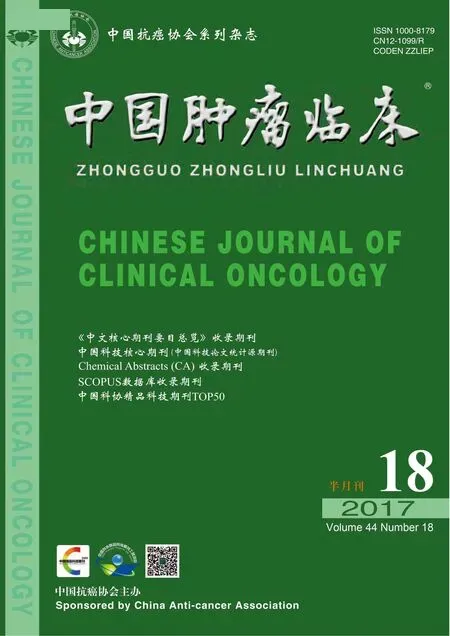节律性化疗在晚期肝细胞肝癌中的应用进展
郭列平 综述 袁振刚 审校
·综 述·
节律性化疗在晚期肝细胞肝癌中的应用进展
郭列平 综述 袁振刚 审校
原发性肝癌是我国常见的消化系统恶性肿瘤,其中以肝细胞肝癌(hepatocellular carcinoma,HCC)为最多见。多数HCC患者确诊时已为晚期,丧失了手术和局部治疗的机会,系统治疗被认为是晚期HCC的主要治疗方式。传统细胞毒类药物化疗对晚期HCC效果不明显,分子靶向药物索拉非尼虽有生存获益,但客观有效率仅为2%~3%,且价格昂贵。节律性化疗由于靶向肿瘤新生血管,在晚期转移性癌症中的治疗作用越来越受到关注。本文拟对节律性化疗在晚期HCC中的治疗进展做一简要综述。
节律性化疗 肝细胞肝癌 系统治疗
原发性肝癌是临床上最常见的消化系统恶性肿瘤之一,其中90%为肝细胞肝癌(HCC)。HCC是世界第5大常见恶性肿瘤,位居世界癌症相关性死亡的第2位[1]。由于乙型肝炎病毒(HBV)感染、水源污染(蓝绿藻类毒素)、酗酒以及黄曲霉素等原因,我国的肝癌超过全球新发病例的50%。局限性HCC可以通过手术切除、局部消融治疗或肝脏移植而治愈[2]。而70%以上的HCC患者在初诊时即为晚期,无法接受根治性手术切除或局部治疗。系统治疗被认为是晚期HCC的主要治疗方式。但是,传统细胞毒类药物化疗对晚期HCC效果不明显[3],并且,多数晚期HCC患者由于慢性肝炎肝硬化所致细胞减少及肝功能异常也不能耐受传统细胞毒类药物化疗。尽管分子靶向药物索拉非尼已被证实作为一线治疗对晚期HCC有生存获益,但其客观有效率很低(仅为2%~3%),不能明显改善临床症状和延长生存,且不良反应较多,价格昂贵,在我国实际上使用索拉非尼的患者仅1%~2%[4]。整体看来,目前针对HCC的系统治疗疗效有限,HCC的治疗仍面临较大困难。
节律性化疗(metronomic chemotherapy)是紧密、规律地给予相对低剂量的细胞毒类药物(如:环磷酰胺、长春碱、拓扑替康、顺铂等)。到目前为止,在PubMed上已有400多篇有关节律性化疗影响肿瘤治疗疗效的临床及临床前研究文章发表,包括胃肠道、呼吸系统、血液、脑、皮肤和泌尿生殖系统的肿瘤。最常被选为节律性化疗的抗肿瘤药物为环磷酰胺。节律性化疗的主要抗肿瘤机制被认为是抑制肿瘤相关血管生成和刺激机体免疫,而不是直接对肿瘤细胞的细胞毒作用[5-8]。近来一些报告显示节律性化疗可以靶向肿瘤干细胞[9],而大剂量环磷酰胺却不能[10]。在多种肿瘤中已被证实节律性化疗不良反应小,患者易耐受[11-14]。其中最值得关注的是节律性化疗尤其联合靶向抗血管新生药物在晚期转移性癌症中的疗效[15]。本文主要介绍节律性化疗在晚期HCC患者中的应用。
作者单位:上海东方肝胆外科医院(上海市201805)
1 节律性化疗与HCC的模型研究
不同节律性化疗方案,如环磷酰胺、替加氟/尿嘧啶(UFT)、顺铂、阿霉素的潜在治疗效果已经在HCC的动物模型中研究[16-17]。Park等[18]报道了环磷酰胺节律性化疗抑制鼠HCC伴肝硬化模型的肿瘤生长,延长存活时间而没有严重不良反应。Tang等[16]发现用环磷酰胺、UFT、和(或)阿霉素组成的单药或双药节律性化疗没有生存获益。相反,在报道了接受不同节律性化疗联合DC101(抗VEGFR-2靶向抗体)对总生存有显著改善,节律性UFT和索拉非尼延迟肿瘤进展和对化疗的耐药[19]。对分子靶向药物如索拉非尼耐药是晚期不可切除HCC经常面临的问题,而节律性化疗联合索拉非尼的临床应用给此类患者带来了希望。Zhou等[20]发现节律性阿霉素联合贝伐单抗可以明显抑制肿瘤生长,延长异种移植模型的生存。Iwamoto等[21]证明了替加氟/吉美嘧啶/奥替拉西(S-1)节律性化疗可抑制肿瘤生长,延长肝癌小鼠生存,当加入口服抑制内皮细胞生长因子受体(EGFR)和血管内皮细胞生长因子受体2(VEGFR-2)vandetanib时,其效果被加强。单独S-1节律性化疗的抗肿瘤效果温和,主要通过上调凝血酶敏感蛋白-1(TSP-1)表达抑制血管生成和抑制肿瘤组织的内皮细胞增殖。考虑到大量S-1引起体重减轻和骨髓抑制,替加氟/吉美嘧啶/奥替拉西(S-1)节律性化疗或S-1节律性化疗联合vandetanib没有引起任何不良反应。在Tang等[19]研究中单药节律性化疗无抗肿瘤效果。然而,在Iwamoto等[21]研究中,不仅S-1节律性化疗联合vandetanib,而且单药S-1节律性化疗也产生明显抗肿瘤效果。其研究结果不同的可能原因是S-1较UFT抗肿瘤效果更强及研究模型不同。
Dai等[22]前期研究发现,靶向在VISA骨干中由肝癌特异性α-fetoprotein启动子/增强器(eAFP)驱动的BikDD(eAFP-VISA-BikDD),在多种原位动物模型中可显著、特异性杀死肝癌细胞。为了加强其治疗效果,将eAFP-VISA-BikDD和化疗试剂联合,发现eAFP-VISA-BikDD联合阿霉素或5-FU对HCC细胞有协同毒性作用。尤其在联合eAFP-VISA-BikDD和阿霉素时,通过增加Bax线粒体易位和胞质细胞色素C释放明显诱导细胞凋亡。与其他试剂单用比较,在鼠原位肝脏异种移植模型中,低剂量阿霉素联合eAFP-VISA-BikDD的抗肿瘤效果更强,更明显延长鼠生存时间。
Jang等[23]用化疗诱导的鼠HCC模型比较环磷酰胺常规大剂量化疗(maximum tolerable dose,MTD)和节律性化疗的不同。发现节律性化疗在延长生存方面更有效,不仅抑制肝内肿瘤生长,也抑制转移灶的形成。其中机制包括:抑制HIF-1α水平和MMPs,包括MMP-2、MMP-9、MMP-2活化剂、TIMP-2;环磷酰胺节律性化疗抑制鼠HCC模型的VEGFR-2表达[18]。
2 节律性化疗相关的HCC临床研究
2.1 单药节律性化疗
2个应用单药节律性化疗治疗晚期HCC的前瞻性临床研究已被报道。Brandi等[24]研究评估了卡培他滨节律性化疗的有效性。给予卡培他滨500mg 2次/d持续治疗晚期HCC,在之前未治疗的59例患者中反应率(RR)为5%,疾病控制率(DCR)为56%,中位无进展生存(PFS)是6个月,中位总生存(OS)14.5个月;而31例对索拉非尼耐药或无法耐受的患者没有反应,但32%的患者疾病稳定,中位PFS是3.3个月,中位OS为9.8个月。疾病控制率(DCR)与之前报道的两个Ⅱ期临床研究(晚期HCC的二线治疗)相似(brivanib的DCR为46%,tivantinib的DCR为42%)。另一个前瞻性研究是评估UFT节律性化疗治疗晚期HCC。Ishikawa等[25]随机分配48例局部进展期HCC患者接受支持治疗或持续接受UFT 400mg 2次/d。在28例接受UFT患者中,RR为18%,中位OS为12.1个月,相反,接受支持治疗的患者中位OS为6.2个月。另有2个用节律性卡培他滨、1个节律性UFT治疗HCC的个案报道,也产生了较好的效果[26-28]。
总体上,这些Ⅱ期节律性化疗研究,已经被证实在应用口服氟尿嘧啶节律性化疗治疗晚期HCC安全可行。卡培他滨或UFT在晚期未经治疗的HCC患者中能诱导肿瘤反应。对索拉非尼耐药或不能耐受的患者,节律性化疗可使32%晚期HCC患者疾病稳定。上述报道证实用卡培他滨或UFT节律性化疗治疗HCC有明显效果,口服氟尿嘧啶节律性化疗可使一些HCC患者临床获益。
2.2 抗血管新生治疗联合节律性化疗
临床前模型证实了节律性化疗联合其他抗血管新生药物的协同抗肿瘤活性[17,19-20]。在亚洲3个单臂Ⅱ期试验和1个回顾性研究评估了各种联合作为晚期HCC的一线治疗。Hsu等[29-30]应用索拉非尼(400mg bid)联合节律性UFT(替加氟125mg/m2,bid)治疗53例Child-Pugh A的晚期HCC患者,评估其有效性和安全性的Ⅱ期临床研究中,发现中位PFS为3.7个月,中位总生存为7.4个月,其中4例患者达到部分缓解(PR),26例患者达到疾病稳定(SD)。治疗的严重不良反应包括:乏力(15%)、肝功能异常(13%)、血清脂肪酶上升(10%)、手足皮肤反应(9%)和出血(8%)。最后作者得出结论:UFT节律性化疗可以安全地联合索拉非尼,与之前报道的用索拉非尼单药治疗类似患者的研究相比较[31-32],这个联合用药可以改善索拉非尼治疗晚期HCC患者的有效性,节律性化疗和索拉非尼联合应用增强了抗肿瘤疗效而未产生严重不良反应。
另一项研究是评估贝伐单抗联合卡培他滨作为一线治疗对晚期HCC患者的可行性及有效性[33]。其中贝伐单抗7.5mg/kg,每3周1次静脉滴注,卡培他滨 800mg/m2口服 2/d,d1~14,间歇1周,每3周重复。总共45例患者进入研究。客观RR为9%,DCR为52%,中位PFS为2.7个月,中位OS为5.9个月。治疗可以很好耐受,没有3~4级血液学毒性,最常见的3~4级不良反应为胃肠道出血(9%)、手足皮肤反应(9%)和腹泻(4%)。
第三个研究是在43例晚期HCC患者中沙利度胺联合UFT作为一线治疗的研究[34]。沙利度胺在晚期HCC患者的单臂II期临床研究中显示临床获益,总反应率(RRs)为3%~7%[35-38]。沙利度胺的抗肿瘤活性归功于其抗血管新生作用,可抑制碱性成纤维细胞生长因子(BFGF)和VEGF诱导的血管生成[39-40]。这个研究中,患者口服沙利度胺200mg/d和UFT(基于替加氟)125mg/m22次/d。被报道RR为9%,DCR为33%,中位PFS是1.9个月,中位OS是4.6个月。治疗中3~4级不良反应很少。最常见的3~4级治疗相关不良反应是嗜睡(9%)、胃肠道出血(5%)、皮疹(2%)和头晕(2%)。
上述3个Ⅱ期临床研究说明联合抗血管新生制剂和节律性口服氟嘧啶化疗的策略可行,并在晚期HCC有令人鼓舞的临床结果,客观RRs为6%~9%,疾病控制率(DCRs)为33%~57%。另一项对42例患者接受沙利度胺和卡培他滨治疗的回顾性研究报告显示RR为14%,DCR为45%[41]。
国内Wang-Yuan等[42]比较了HCC患者冷循环射频消融(RFA)后应用节律性卡培他滨和沙利度胺与RFA的疗效。HCC患者被随机分配至治疗组(RFA后节律性卡培他滨和沙利度胺,共22例)和对照组(仅接受RFA,共28例)。1个月后,肿瘤反应率(TRR),包括完全反应和部分反应率,在试验组和对照组相似。在12个月时,试验组的TRR为68%,明显高于对照组35.7%。治疗1个月后,血清循环内皮细胞(CECs)和血管内皮细胞生长因子(VEGF)水平,在实验组明显低于基线,而在对照组明显增高。随访12个月后,试验组的PFS为2个月。因此,RFA后节律性卡培他滨和沙利度胺明显降低了HCC患者的复发,延长了PFS,其机制可能是通过减少血清CECs和VEGF水平及抑制肿瘤血管新生。
2.3 节律性化疗联合其他药物研究
Treiber等[43]将38例晚期HCC患者随机分配进入4个治疗组:组1在第1天接受30mg奥曲肽,组2在第1天接受30mg奥曲肽和每天400mg伊马替尼,组3在第1天接受60~90mg/m2奥沙利铂,组4在第1、8、15天接受20~30mg/m2奥沙利铂联合30mg奥曲肽d1和每天400mg伊马替尼。在这个Ⅰ/Ⅱ期临床试验中,组间的治疗至进展时间(TTP)及OS没有明显差别。Woo等[44]报道了一项Ⅱ期临床研究,注射节律性表阿霉素联合顺铂和5-FU对HCC伴有门静脉癌栓安全可行[中位生存时间(MST):162天]。Allegrini等[45]报道了节律性UFT和环磷酰胺联合塞来昔布治疗严重胃肠道恶性肿瘤患者,包括2例HCC,均很好耐受且疗效明显。
为了证实节律性化疗在晚期HCC患者的有效性和安全性,更多其他抗肿瘤试剂和分子靶向制剂的随机Ⅱ期临床研究包括随机对照研究将在大范围人群中开展。
3 小结
HCC是一种典型血管富集的实体肿瘤,血管新生在HCC的发生、发展过程中发挥着重要的作用,联合应用抗血管新生药物和节律性化疗可以增强二者的抗肿瘤疗效。目前针对HCC尚无有效的标准化疗方案,节律性化疗由于其低毒及多重作用机制,已成为HCC尤其是晚期HCC患者可选择的治疗策略,或作为术后辅助治疗,有待进一步研究。
[1]Global Burden of Disease Cancer Collaboration,Fitzmaurice C,Allen C,et al.Global,Regional,and National Cancer Incidence,Mortality,Years of Life Lost,Years Lived With Disability,and Disability-Adjusted Life-years for 32 Cancer Groups,1990 to 2015:A Systematic Analysis for the Global Burden of Disease Study[J].JAMA Oncol,2017,3(4):524-548.
[2]Llovet JM,Bru C,Bruix J.Prognosis of hepatocellular carcinoma:the BCLC staging classification[J].Semin Liver Dis,1999,9(3):329-338.
[3]Lopez PM,Villanueva A,Llovet JM.Systematic review:evidencebased management of hepatocellular carcinoma-an updated analysis of randomized controlled trials[J].Aliment Pharmacol Ther,2006,23(11):1535-1547.
[4]Gong X,Qin S.Research progress on treatment of sorafenib for Chinese patients with advanced hepatocellular carcinoma[J].J Clin Oncol,2015(2):175-184.[龚新雷,秦叔逵.索拉非尼治疗国人晚期肝细胞癌的临床研究进展[J].临床肿瘤学杂志,2015(2):175-184.]
[5]Kerbel RS,Kamen BA.The anti-angiogenic basis of metronomic chemotherapy[J].Nat Rev Cancer,2004,4(6):423-436.
[6]Kerbel RS.Inhibition of tumor angiogenesis as a strategy to circumvent acquired resistance to anti-cancer therapeutic agents[J].Bioessays,1991,13(1):31-36.
[7]Loeffler M,Krüger JA,and Reisfeld RA.Immunostimulatory effects of low-dose cyclophosphamide are controlled by inducible nitric oxide synthase[J].Cancer Res,2005,65(12):5027-5030.
[8]Lutsiak ME,Semnani RT,De Pascalis R,et al.Inhibition of CD4+25+T regulatory cell function implicated in enhanced immune response by low-dose cyclophosphamide[J].Blood,2005,105(7):2862-2868.
[9]Martin-Padura I,Marighetti P,Agliano A,et al.Residual dormant cancer stem-cell foci are responsible for tumor relapse after antiangiogenic metronomic therapy in hepatocellular carcinoma xenografts[J].Lab Invest,2012,92(7):952-966.
[10]Folkins C,Man S,Xu P,et al.Anticancer therapies combining antiangiogenic and tumor cell cytotoxic effects reduce the tumor stemlike cell fraction in glioma xenograft tumors[J].Cancer Res,2007,67(8):3560-3564.
[11]Baruchel S,Diezi M,Hargrave D,et al.Safety and pharmacokinetics of temozolomide using a dose-escalation,metronomic schedule in recurrent paediatric brain tumours[J].Eur J Cancer,2006,42(14):2335-2342.
[12]Sung CC,Chang PY,Cheng MF,et al.Successful metronomic lowdose cyclophoaphamide therapy in an older patient with advanced mucosa-associated lymphoid tissue lymphoma[J].Ann Hemstol,2009,88(12):1257-1259.
[13]Zhou F,Guo L,Shi H,et al.Continuous administration of low-dose cyclophosphamide and prednisone as a salvage treatment for multiple myeloma[J].Clin Lymphoma Myeloma Leuk,2010,10(1):51-55.
[14]Yang H,Woo HY,Lee SK,et al.A comparative study of sorafenib and metronomic chemotherapy for Barcelona Clinic Liver Cancer-stage C hepatocellular carcinoma with poor liver function.[J].Clin Mol Hepatol,2017,23(2):128-137.
[15]Hashimoto K,Man S,Xu P,et al.Potent preclinical impact of metronomic low-dose oral topotecan combined with the antiangiogenic drug pazopanib for the treatment of ovarian cancer[J].Mol Cancer Ther,2010,9(4):996-1006.
[16]Tang TC,Man S,Lee CR,et al.Impact of metronomic UFT/cyclophosphamide chemotherapy and antiangiogenic drug assessed in a new preclinical model of locally advanced orthotopic hepatocellular carcinoma[J].Neoplasia,2010,12(3):264-274.
[17]Shen FZ,Wang J,Liang J,et al.Low-dose metronomic chemotherapy with cisplatin:can it suppress angiogenesis in H22 hepatocarcinoma cells[J]?Int J Exp Pathol,2010,91(1):10-16.
[18]Park ST,Jang JW,Kim GD,et al.Beneficial effect of metronomic chemotherapy on tumor suppression and survival in a rat model of hepatocellular carcinoma with liver cirrhosis[J].Cancer Chemother Pharmacol,2010,65(6):1029-1037.
[19]Tang TC,Man S,Xu P,et al.Development of a resistance-like phenotype to sorafenib by human hepatocellular carcinoma cells is reversible and can be delayed by metronomic UFT chemotherapy[J].Neoplasia,2010,12(11):928-940.
[20]Zhou F,Hu J,Shao JH,et al.Metronomic chemotherapy in combination with antiangiogenic treatment induces mosaic vascular reduction and tumor growth inhibition in hepatocellular carcinoma xenografts[J].J Cancer Res Clin Oncol,2012,138(11):1879-1890.
[21]Iwamoto H,Torimura T,Nakamura T,et al.Metronomic S-1 chemotherapy and vandetanib:an efficacious and nontoxic treatment for hepatocellular carcinoma[J].Neoplasia,2011,13(3):187-197.
[22]Dai HY,Chen HY,Lai WC,et al.Targeted expression of BikDD combined with metronomic doxorubicin induces synergistic antitumor effect through Bax activation in hepatocellular carcinoma[J].Oncotarget,2015,6(27):23807-23819.
[23]Jang JW,Park ST,Kwon JH,et al.Suppression of hepatic tumor growth and metastasis by metronomic therapy in a rat model of hepatocellular carcinoma[J].Exp Mol Med,2011,43(5):305-312.
[24]Brandi G,de Rosa F,Agostini V,et al.Metronomic capecitabine in advanced hepatocellular carcinoma patients:a phase II study[J].Oncologist,2013,18(12):1256-1257.
[25]Ishikawa T,Ichida T,Sugitani S,et al.Improved survival with oral administration of enteric-coated tegafur/uracil for advanced stage IVA hepatocellular carcinoma[J].J Gastroenterol Hepatol,2001,16(4):452-459.
[26]Ballardini P,Marri I,Margutti G,et al.Long-lasting response with metronomic capecitabine in advanced hepatocellular carcinoma[J].Tumori,2010,96(5):768-770.
[27]Brandi G,de Rosa F,Bolondi L,et al.Durable complete response of hepatocellular carcinoma after metronomic capecitabine[J].Tumori,2010,96(6):1028-1030.
[28]Ishikawa T,Ichida T,Ishimoto Y,et al.Complete remission of multiple hepatocellular carcinomas associated with hepatitis C virus-related,decompensated liver cirrhosis by oral administration of enteric-coated tegafur/uracil[J].Am J Gastroenterol,1999,94(6):1682-1685.
[29]Hsu CH,Shen YC,Lin ZZ,et al.Phase II study of combining sorafenib with metronomic tegafur/uracil for advanced hepatocellular carcinoma[J].J Hepatol,2010,53(1):126-131.
[30]Hsu CY,Shen YC,Yu CW,et al.Dynamic contrast-enhanced magnetic resonance imaging biomarkers predict survival and response in hepatocellular carcinoma patients treated with sorafenib and metronomic tegafur/uracil[J].J Hepatol,2011,55(4):858-865.
[31]Cheng AL,Kang YK,Chen Z,et al.Efficacy and safety of sorafenib in patients in the Asia-Pacific region with advanced hepatocellular carcinoma:a phase III randomised,double-blind,placebo-controlled trial[J].Lancet Oncol,2009,10(1):25-34.
[32]Yau T,Chan P,Ng KK,et al.Phase 2 open-label study of single-agent sorafenib in treating advanced hepatocellular carcinoma in a hepatitis B-endemic Asian population:presence of lung metastasis predicts poor response[J].Cancer,2009,115(2):428-436.
[33]Hsu CH,Yang TS,Hsu C,et al.Efficacy and tolerability of bevacizumab plus capecitabine as first-line therapy in patients with advanced hepatocellular carcinoma[J].Br J Cancer,2010,102(6):981-986.
[34]Shao YY,Lin ZZ,Hsu C,et al.Efficacy,safety,and potential biomarkers of thalidomide plus metronomic chemotherapy for advanced hepatocellular carcinoma[J].Oncology,2012,82(1):59-66.
[35]Hsu C,Chen CN,Chen LT,et al.Low-dose thalidomide treatment for advanced hepatocellular carcinoma[J].Oncology,2003,65(3):242-249.
[36]Lin AY,Brophy N,Fisher GA,et al.Phase II study of thalidomide in patients with unresectable hepatocellular carcinoma[J].Cancer,2005,103(1):119-125.
[37]Patt YZ,Hassanmm,Lozano RD,et al.Thalidomide in the treat-ment of patients with hepatocellular carcinoma:a phase II trial[J].Cancer,2005,103(4):749-755.
[38]Wang TE,Kao CR,Lin SC,et al.Salvage therapy for hepatocellular carcinoma with thalidomide[J].World J Gastroenterol,2004,10(5):649-653.
[39]Kenyon BM,Browne F,D'Amato RJ.Effects of thalidomide and related metabolites in a mouse corneal model of neovascularization[J].Exp Eye Res,1997,64(6):971-978.
[40]Kruse FE,Joussen AM,Rohrschneider K,et al.Thalidomide inhibits corneal angiogenesis induced by vascular endothelial growth factor[J].Graefes Arch Clin Exp Ophthalmol,1998,236(6):461-466.
[41]Ang SF,Tan SH,Toh HC,et al.Activity of thalidomide and capecitabine in patients with advanced hepatocellular carcinoma[J].Am J Clin Oncol,2012,35(3):222-227.
[42]Wang-Yuan Z,Jiang-Zheng Z,Lu YD,et al.Clinical efficacy of metronomic chemotherapy after cool-tip radiofrequency ablation in the treatment of hepatocellular carcinoma[J].Int J Hyperthermia,2016,32(2):193-198.
[43]Treiber G,Wex T,Malfertheiner P.Impact of different anticancer regimens on biomarkers of angiogenesis in patients with advanced hepatocellular cancer[J].J Cancer Res Clin Oncol,2009,135(2):271-281.
[44]Woo HY,Youn JM,Bae SH,et al.Efficacy and safety of metronomic chemotherapy for patients with advanced primary hepatocellular carcinoma with major portal vein tumor thrombosis[J].Korean J Hepatol,2012,18(1):32-40.
[45]Allegrini G,Di Desidero T,Barletta MT,et al.Clinical,pharmacokinetic and pharmacodynamic evaluations of metronomic UFT and cyclophosphamide plus celecoxib in patients with advanced refractory gastrointestinal cancers[J].Angiogenesis,2012,15(2):275-286.
Progress on metronomic chemotherapy for advanced hepatocellular carcinoma
Lieping GUO,Zhengang YUAN
Department of Oncology,Shanghai Eastern Hepatobiliary Surgery Hospital,Shanghai 201805,China
Primary liver cancer,particularly hepatocellular carcinoma(HCC),is a common type of digestive tumor in China.The majority ofHCCpatientsisdiagnosedwithadvancedstageandthuscannotbetreatedwithsurgeryandlocal treatment.Systemictherapyisconsidered to be the main treatment of advanced HCC.The effect of traditional cytotoxic drug chemotherapy on advanced HCC is not evident.Although sorafenib,a molecular-targeted drug,has survival benefits,this drug is expensive and has low objective effective rate of only 2%-3%.Metronomic chemotherapy has
increasing attention because it targets tumor angiogenesis for the treatment of advanced metastatic cancer.This article aimed to review the progress of metronomic chemotherapy in advanced HCC treatment.
metronomic chemotherapy,hepatocellular carcinoma,systemic therapy
Zhengang YUAN;E-mail:yuanzhengang@163.com

10.3969/j.issn.1000-8179.2017.18.340
袁振刚 yuanzhengang@163.com
(2017-04-01收稿)
(2017-06-07修回)
(编辑:郑莉 校对:杨红欣)
郭列平 专业方向为节律性化疗在血液及肿瘤的临床基础研究。
E-mail:glplaying2000@163.com

